As teachers we often work with students whose frontal lobes are still very much in development. Things that we often take for granted as adults, such as time management, following directions, organizing, planning ahead, and multitasking are behaviors students are still learning. But it’s important to know that these are areas teachers can often improve in as well. And while my frontal lobe, as far as I can tell, is fully developed, and I’m beyond the stage where I might jump on the back of a moving U-Haul and ride away from EPS (this actually happened), there’s still work to be done when it comes to executive functioning.
Professionalism | Executive Functioning
(1) approaches recommendations for improvement receptively and responsively
It’s a challenge for many not to internalize a recommendation for improvement as a criticism of one’s job performance. If someone, student or colleague, offers a recommendation or suggestion on my work in the classroom, I didn’t do it ‘correctly’, right? Something that working at EPS has taught me is to seek out and embrace recommendations for improvement. This started early in my career here when I had visitors from the English discipline as well as SLT dropping into my classroom to see how things were going. After class we would connect in person or via email about the lesson. As further explained in indicator two, these conversations were not punitive, nobody was trying to ‘catch’ me, rather they were simply a way to get another set of eyes on my curriculum design, classroom management, and interactions with students and faculty.
I often find opportunities for improving my practice while working with others in the English discipline designing and refining curriculum and assessments. Each trimester often affords an opportunity to work collaboratively fine tuning assignments that I may have created years ago by integrating the recommendations of my fellow teachers. It keeps the content fresh and I often walk away knowing more about the subject as well. The Latin American Literature CIA Dossier project and the Middle Eastern/American Literature Graphic Novel projects are great examples of this.
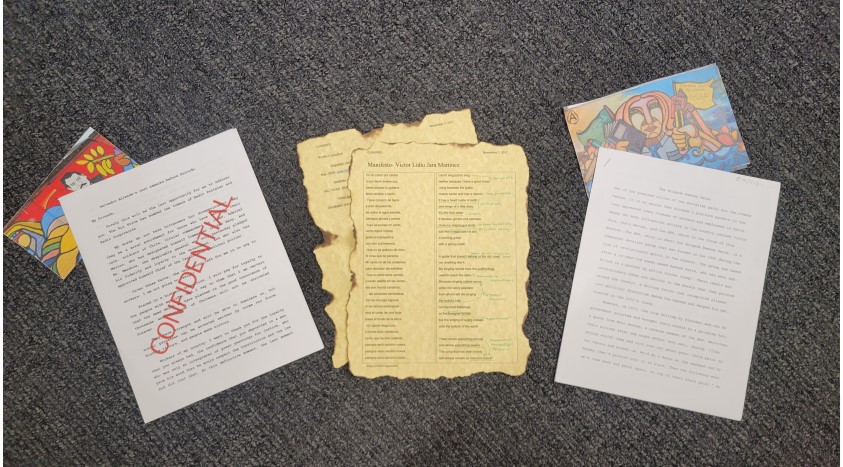
These were projects created years ago that existed solely in the English discipline. Over the years, working with Jeff Bandel and Wen Yu Ho these projects have developed and improved into a larger project celebrating what students have learned in the English and social science classes.
(2) displays openness and comfort with visitors observing class
Allowing visitors in the classroom can be both exciting and produce a little anxiety. What if the students aren’t on their best behavior, what if I say the wrong thing, what if the person observing knows more than me about the topic? My anxiety probably stems from my observations at other institutions in which an administrator, more often than not one I did not know, would select a day and come observe my class. With a multipage checklist in hand they would grade my performance ticking boxes along the way ensuring I hit a litany of standards. The lesson was a dog and pony show designed to simply show that I had read and understood standards set by the state government. There was no conversation before the observation, no follow up afterward, and since all new teachers were hired on provisional employment, my future at the school was contingent in part on these observations.
Over the years I’ve grown more comfortable allowing visitors in the classroom, which I think is in part to the way observations are structured and used at EPS. I remember the first time I was observed by then upper school head Bart Gummere. We had a conversation before the visit to talk about my experience in the classroom thus far, areas where I felt confident in and areas where I hoped to improve. After my visit I was provided some notes on the period. No check boxes, no score, simply his observations of what happened during the class and some notes connected to our prior conversation. We had a follow up meeting to discuss the class and my teaching experience overall. My ultimate takeaway from this experience was a personal desire to have more people in my classroom observing my teaching and to get myself into other classrooms as often as I could.
Some ways I’ve been observed and have observed others are :
-Mentor/mentee class observations
-Visits from the upper school head and head of school
-Observations from other members of the English and social science discipline
-Dropping in on other classes on campus
-Welcoming visitors from other schools to my classroom as well as observing others teach in different schools
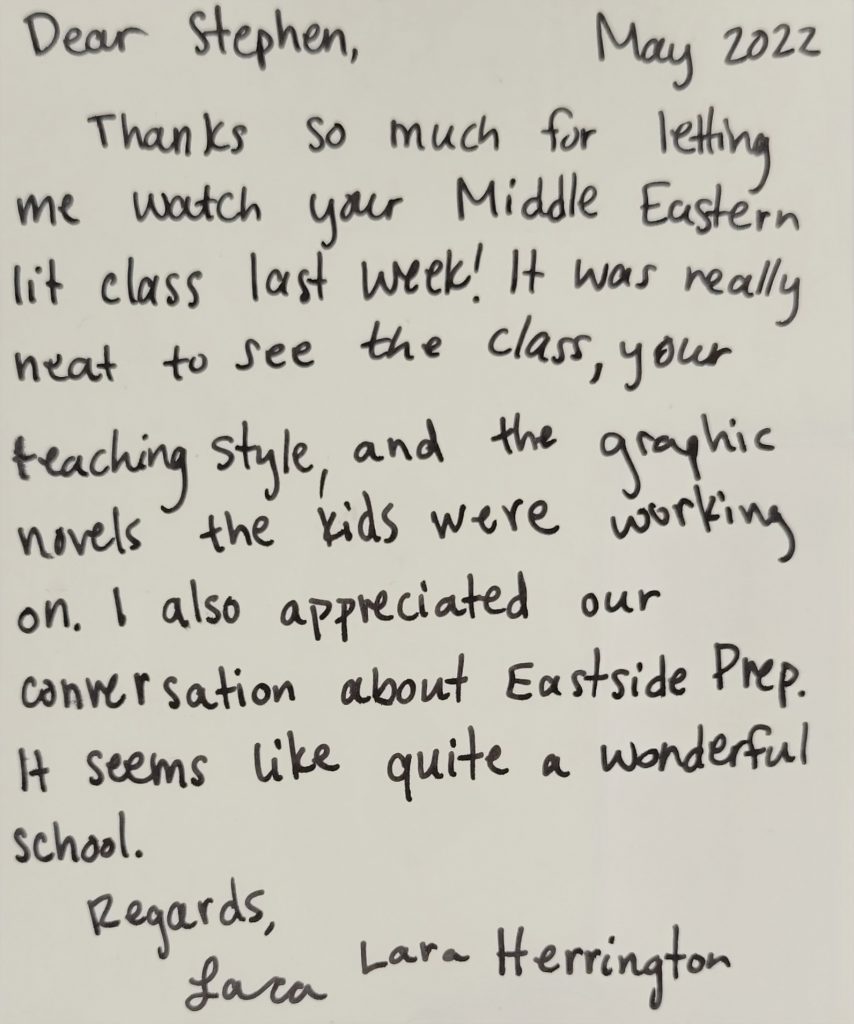
(3) seeks out diverse opinions of others for guidance
When you don’t know, ask. I’m thankful for how tremendously helpful folks are at EPS when I have questions and need help on my practice. One of the most common departments I seek guidance is from the Learning Support team. The teachers in Learning Support provide a tremendous resource when designing curriculium or creating assessments. Perhaps the most helpful thing they have taught me is the importance of scaffolding assignments so that students with learning differences are able to approach their work with more confidence and understanding.
Some areas I seek the opinions of others for guidance include
- GLC team meetings with John Stegeman and other Grade Level Coordinators
- Meetings with the 10th grade team
- Learning Support
- Other teachers in the English discipline
[I FEEL LIKE I NEED SOMETHING ELSE HERE BUT I”M NOT SURE WHAT]
(4) manages and prioritizes professional tasks and responsibilities
If there was ever a time in which prioritizing professional tasks and responsibilities would be most important it would be the 2021-2022 school year. Returning from remote school to campus had it’s own challenges but my responsibilities at EPS outside the classroom this year have expanded as well.
Responsibilities outside of teaching:
- The student newspaper
- Middle school cross country
- PDP
- First year in the Grade Level Coordinator position
- Co-planned an entirely new EBC experience
My experience in the role of Grade Level Coordinator has especially illustrated to me the importance of managing professional tasks and responsibilities. In this role, my collegues rely on my to set the agenda for our weekly meetings, provide a detailed calendar and plans for our advisory and class meetings, and be available in case any questions come up.
Over the years I’ve experimented with various forms of managing my to-do list, from daily planners, stickie notes, wall calendars, and digital to do lists. Currently I use the program Microsoft To Do coupled with Outlook to keep track of my meetings as well as what I need to do daily. I create appointments in Outlook at the start of the week allocating time to complete individual tasks such as grading papers and prepping class for the following week. With all the various meetings, responsibilities, and activities I’m involved in prioritization is important. Responding to colleagues, parents, and students tend to take precedence over things less time sensitive. I’ve also learned to give myself a break, it’s impossible to do all the things on my to do list in a day and as soon as I complete one task, another pops up. It’s okay to close the computer and save it for the next day.
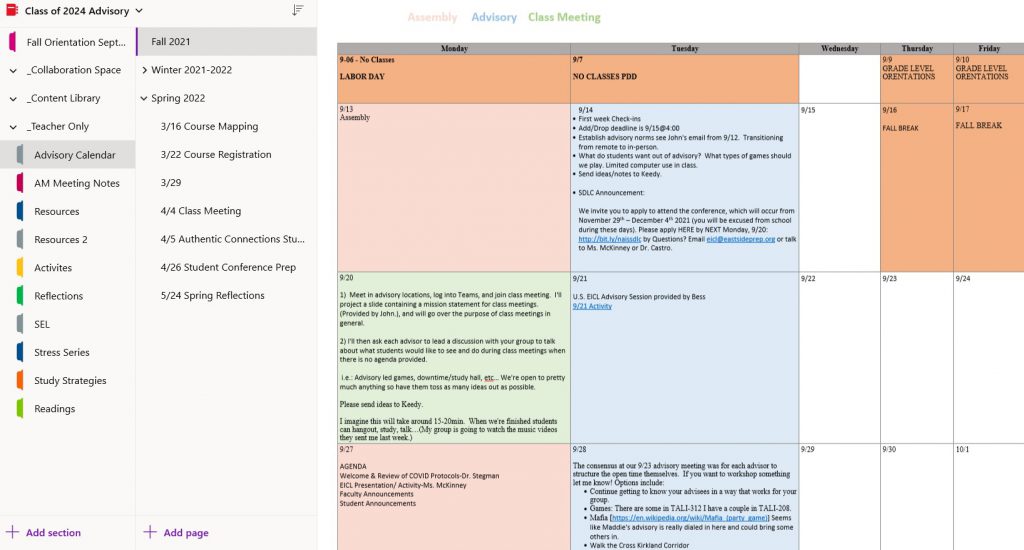

(5) communicates and responds to students, parents, and colleagues in a timely and constructive manner
At EPS, teachers live and die by their Outlook inbox and calendar. There are literally thousands of emails that have come and gone through my inbox. Teachers, parents, students, administrators, all communicate by email and it can be a lot to keep track of. It’s easy to spend an entire free period, an afternoon, or evening at home catching up on these emails. In the past couple years as I’ve taken on more responsibilities I’ve seen my inbox fill up faster and realized a need to triage my messages to make sure I am responding in the most efficient, appropriate manner.
For example, I know that a quick response to a message can go a long way. If a parent, student or colleague emails me and I know that I’m not going to be able to provide a thoughtful response quickly I’ll often let them know that I’ve seen their message and will respond soon with an answer. This helps to alleviate the feeling that one’s message has gotten lost in the shuffle of emails. I always try and respond to questions from collegues, parents, and students as quickly as possible.
An additional aspect of communication at EPS is that many of us have email on our mobile phones. The question of “When do I stop?” comes up. When members of the community are sending emails into the night, I sometimes feel I need to as well. I’ve addressed this in a few ways:
- Sometimes I simply turn my email off on my phone and computer in the evenings. While this might feel counter to the spirits of this indicator, I’ve realized that I don’t have to respond to every email as soon as it hits my inbox, even if I can.
- For students, I’ve often used email as a way to open and encourage an in-person dialogue instead of an email correspondence. Students often ask me for general feedback on their writing, if an assignment is ‘good enough’, or if I can look something over. I use these messages as a teaching moment encouraging students to set up a time to meet with me in person during office hours or a shared free period.
Assessment Practice
Formative and summative assessment are a necessary element within the classroom to check in on student progress, ensure students are learning the material, and to see if any intervention needs to take place. Some students thoroughly enjoy being tested, the ability to and recognition of the mastery of course materials is often a motivating and validating experience. For others, formal and informal assessment can bring about significant anxiety, fear, and worry. It can be a challenge, and to be honest, nearly impossible, to design formative and summative assessment that are authentic, challenging and meaningful as well as fair to all students in the classroom.
Central to my assessment practice is the idea that students should be offered several different ways to show their knowledge throughout the term. Assessments in my class range from a 10 page college level research paper to designing and building a Medieval shield that connects to students lives outside of school, to a formal debate on critical literary theory. I believe that assessments, while they often have a bad name, can be designed in a way that both pushes the student academically while also being a fun and unique way to show one’s knowledge.
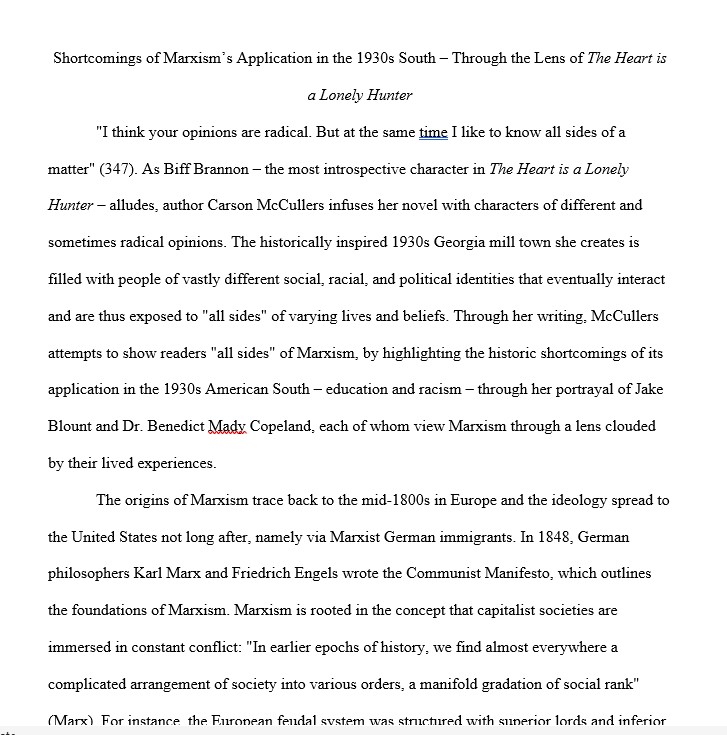
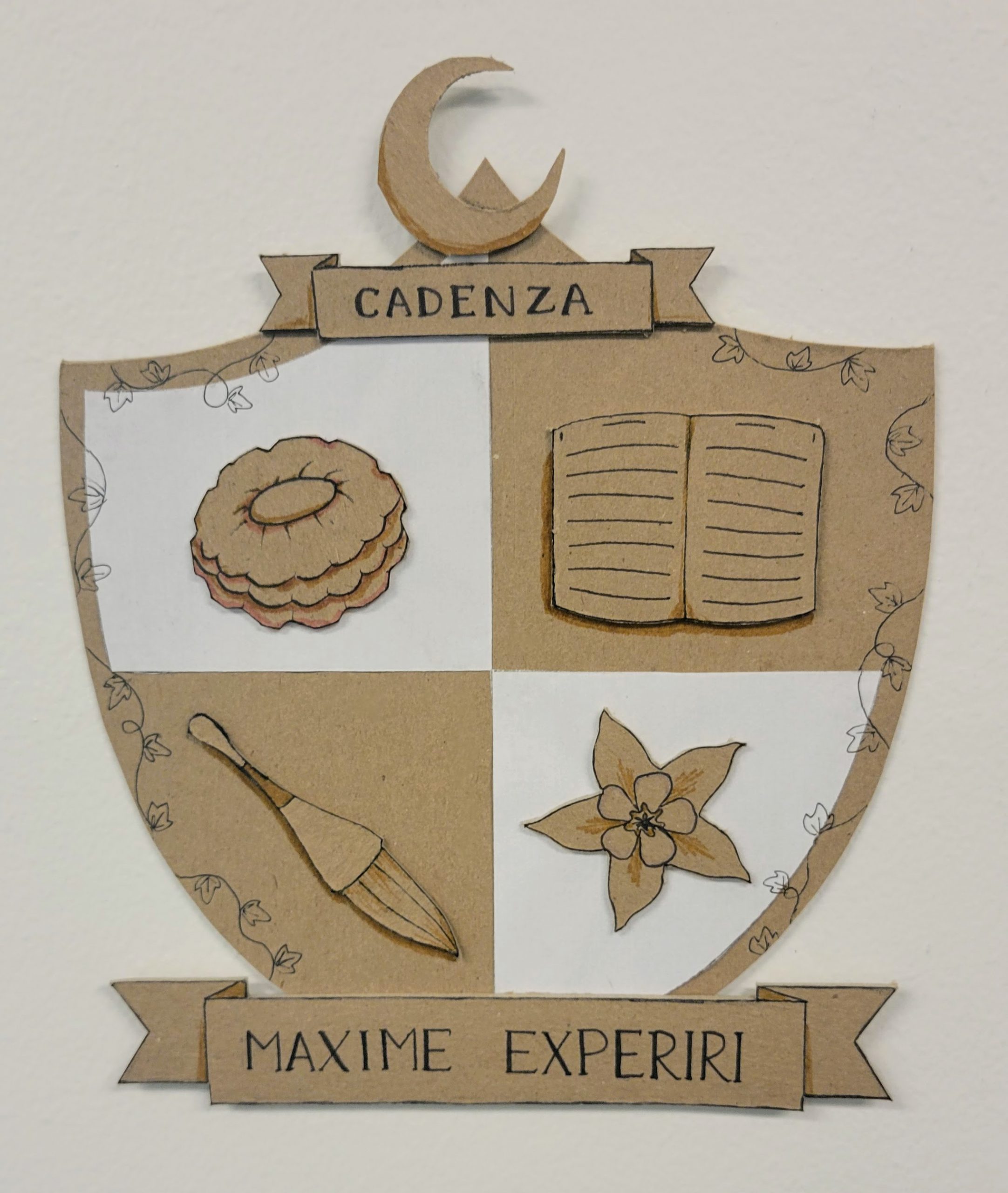
(1) designs major assessments that reflect course outcomes and posts them at the start of each trimester
Most courses I teach contain around three to four major assessments per trimester. A mid-term project, a final exam, an engagement and participation grade, and usually one additional project. In the past it was a challenge both designing and posting these before the trimester began as it was hard to know just how quick or slow we would move through the material. Additionally, course objectives and outcomes differ depending the class, grade level, and time of year.
Because I’ve taught many of these courses for several years and have a better sense of just how long it takes to move through the material I’m able to post all the major assessments as well as readings at the start of the trimester. Our students have a lot of responsibilities both in and out of school, from juggling assignments and homework in seven class, playing sports, and the extra-curricular activities they do on their own; they need to know what to expect during a trimester so they can better plan their days and weeks. Posting these at the start of the trimester is helpful for both the students and myself when it comes to organization.
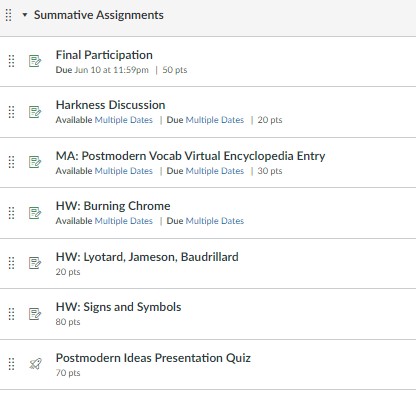
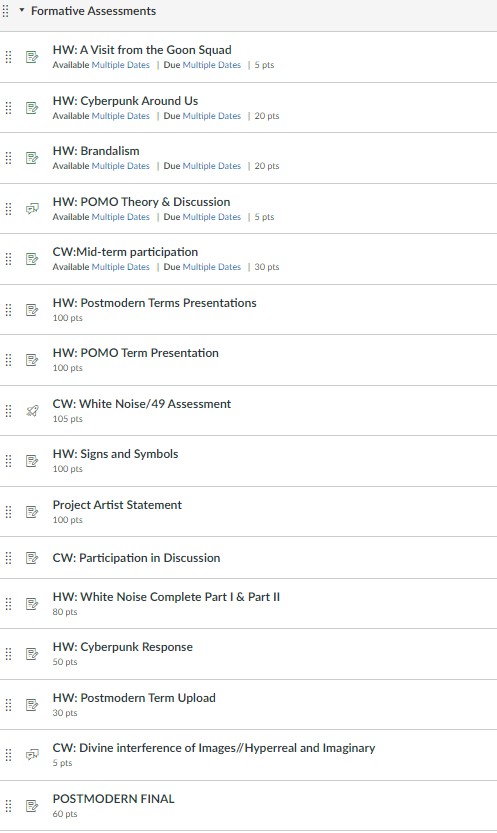
(2) designs assignments to be graded and returned in a feedback cycle of seven calendar days
It’s important that students receive thoughtful feedback in a timely manner so they can see what they did that was positive as well as make any changes necessary to their work in the future. That said, returning substantive and thoughtful feedback on assignments within seven days is a challenge for many teachers, myself included. When in the midst of EBC planning, GLC coordination, lesson planning, collaboration with colleagues, and trying to find some time for yourself on the weekend, getting 70 essays returned in seven days can be a challenge.
Over the years I have experimented with a few different types of assessment feedback with the goal of returning assignments to students in a timely manner while also providing thoughtful and actionable feedback. For assignments that are lower-stakes and do not require robust feed back grading on completion saves time and indicates to the student whether or not they have meet the standard. I also find it important for the students to occasionally assess themselves when it comes to their participation and engagement in class. I’ve found students to be quite honest when it comes to self-assessment. This has the added element of providing more transparency when grading student work.
- Rubrics [hyperlink]
- Face-to-face grading
- Student Self-Assessment
- Assignments graded on a complete/incomplete basis
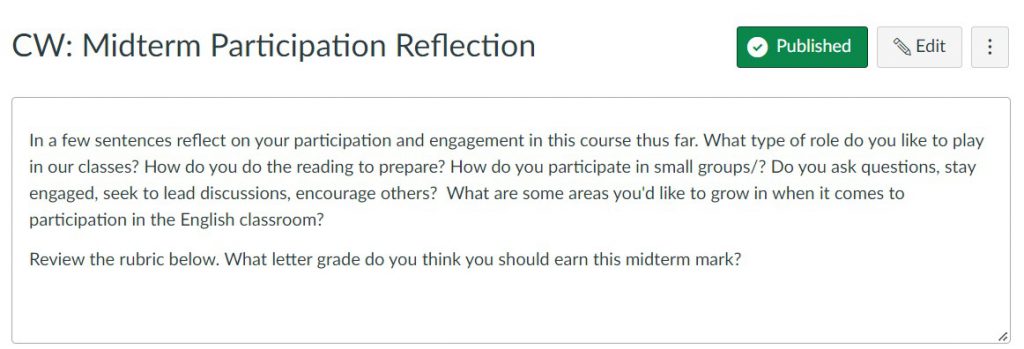
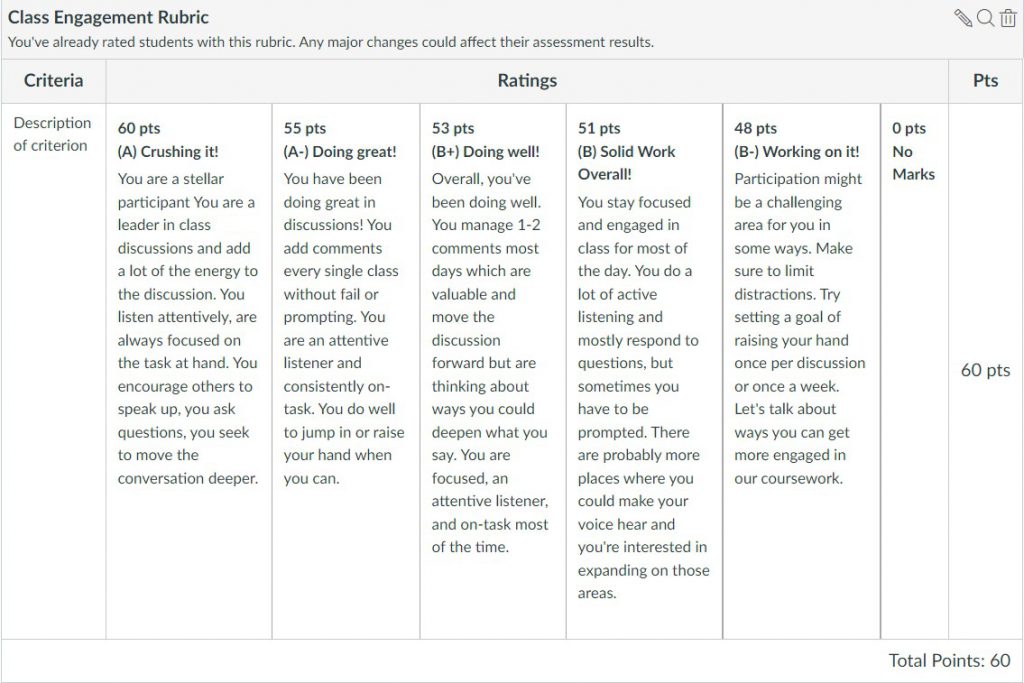
(3) ensures the number of assignments in each course is neither excessive nor deficient — providing appropriate time for quality student performance and meaningful teacher feedback
It’s difficult to know at the start of a trimester exactly how many assignments will be assigned over the course of the term. The varying abilities of different classes, commitments outside of school, as well as student mental health all play an important role when determining how many assignments students should expect during a trimester. Flexibility is also important when it comes to creating assessments and allowing enough time for quality student performance. I’ve often ask for students candid feedback when it comes to the number of assignments and the length of the in my class. Based on these conversations I’ve either increased or decreased the amount of readings and assignments. The English discipline usually expects students to spend around 30 minutes on homework assignments.
[START WITH A PLAN AND ADAPT? DOES THAT WORK EVERY TIME? HOW OFTEN DO YOU NEED TO CHANGE? DO YOU ASK OTHER TEACHERS WHO HAVE TAUGHT THE CLASS BEFORE?]